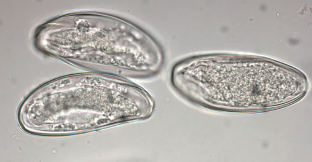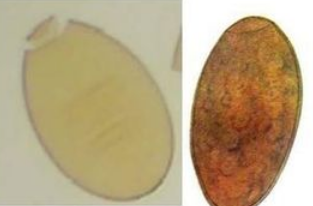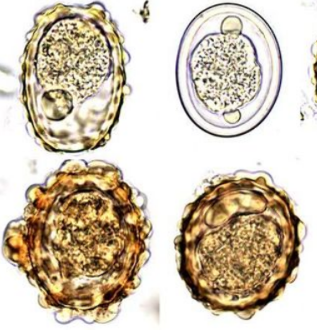Worms is the scientific name for parasites-worms. How are the eggs of worms, of interest to many, because they be guests in our body. They live in the bodies of man, animal and plants. Most of these parasites have long adapted to life in the open fresh air, earth and water. Their eggs are in the ground, water and even "soar" in the air.

Some information about the bot
To date studied more than 300 species of helminthes, 70 of which live on the territory of our country. The world Health Organization took the bot to critical infections. The number of infections with helminths may vary from 20 to 22 million people.
To helminth worms usually considered one of 3 classes:
- Flat worms (tape) – very long, feed on blood of the host. The most common bovine and porcine cepni, Echinococcus.
- Roundworms (nematodes) – have different sizes, different sexes. The most common are roundworms and pinworms.
- Flukes are always bisexual biohelminths, the head has suckers, with their help the worm attach to the organs of the host. These include schistosomiasis and others.
The presence of worms is dangerous for a few key reasons:
- parasites can inflict mechanical damage to the internal organs;
- cause a violation of the metabolism;
- waste products of worms poison the host organism;
- the presence of the worms can provoke other diseases.
Worms lay eggs that enter the human body mainly through the alimentary (food or water), or failure to comply with hygiene standards.
Description of the appearance and structure of the most famous worms
| Worms | Appearance | Structure |
| Pinworms | It's a small round worms are white, usually their size is not more than 1 cm. | On the front of the body of pinworms is the vesicle. With its help, helminth attached to the inside of the intestine, causing mechanical damage. The other end of the worm is pointed. Hence the name pinworm. |
| Roundworm | A large worm, a length of about 20 cm and a width of 6 mm. the Female is much larger than the male. Is red-white with a curved tail. | The body of a roundworm is covered with a strong cuticle, which does not dissolve even gastric juice. At the head end roundworm has a mouth, around the mouth, the three lips.
Immediately behind the mouth in the body of a roundworm is the esophagus and the intestines, consisting of a straight tube. The parasite remains only to swallow cooked food and to digest it. |
| Whipworm | A small worm. In a length of 5 cm and a width no thicker than a human hair, not more than 0,5 mm. Has a sharp end, clings to them for the mucous membranes. | The front end of the helminth (3-5 cm) refined to the thickness of the hair. The rear end is thicker than the front. It has the intestines. The female in the rear end is the uterus. |
| Toxocara | In Toxocara reaches up to 10 cm in length. The males are smaller.
|
Toxocara worm white. Her body is elongated, resembles a thin cylinder. The mouth has three lips. |
| The species Trichinella | Applies to round worms of small size. A length of not more than 5 mm. | Their main feature of the structure is a one-way gastrointestinal tract. |
| Beef tapeworm (tapeworm) | The worm is very large size. Has a long body in the form of a tape. How many meters in a length beef tapeworm?! He giant size of up to 30 meters! | Scolex (head) has 4 strong suction cups without hooks. The head of the specimen is small. The neck segments are growing, their number is from 1 to 2 thousand. Uterus well developed, filled with a transparent egg. Mature tapeworm segments are separated, moved with the faeces, or separately come out from the intestines. |
| Pork tapeworm
(specimen) |
Its structure is very similar to the bovine tapeworm. But the size of it several times less bullish tapeworm – not more than 3-5 m. | Pork tapeworm is also called the armed tapeworm. On his head except for the 4 cups, there are 32 hooks. Tapeworm segments are about 50 thousand eggs. |
| Tapeworm broad | Another long worm, its length can be over 10 m | The body of the worm consists of a small flat head, no more than 5 mm, With the two sides there is a long flat slit-like suckers. Them the worm clings to the intestinal wall. |
| Echinococcus | Belongs to the class of tape worms, helminth small sizes. His head has hooks and suckers. | The tapeworm consists of 3-4 segments. "Armed" parasite suckers and hooks. In segments of the parasite are located sex organs, and the third eggs. They separate their segments, and they have the ability to move independently. |
| Opisthorchiasis small | Small worm, up to 1 cm On the head has a mouth sucker. | The worm has 2 suckers, which is fixed on a smooth surface. There are oral and ventral sucker. From the oral sucker is the pharynx, and behind it the gullet and intestine. In the posterior end of the parasite is the excretory organ. |

Features of the life cycle of worms
The duration of life span in worms is different. In some it may last a year or two, and other parasites more than 10-15 years! So among helminths has its centenarians. For example, pinworms do not live long, not more than 6 months. Their fertility is high enough. Due to the fact that the eggs of pinworms are very light, they can be even in the air we breathe.
The eggs of roundworm and whipworm enter the body through food
Roundworm and whipworm live more than 2 years. First live to 2 years and the last 3-4 years. But it's not the worst numbers!
But the record holder among the worms, which cause great harm in the human body is the pork tapeworm. Its lifespan reaches up to 20-30 years!
Experts, puts various tests and experiments on worms, concluded that the temperature of the habitat affects the behavior of the helminth. When the temperature of the body of the patient Ascaris spontaneously leaves the body. So at a temperature of 40°C the activity of the roundworm has increased several times.
Lowering the temperature in the environment causes the worms to take action – departing from the body.
One method of disinfection is heat treatment. For example, to the fish killed the parasite, it is sufficient to boil it for 30 minutes. Freezing at different temperatures will accelerate the treatment process. At a temperature of -15°C, the freezing period is 30 days. At -35°C is only 10 hours.
How many need degrees to disinfect products? The eggs of ascarids are killed at a temperature of +55°C. Handling toys in the water at the temperature of +70°C will take several seconds.
Egg-laying worms
Most parasites lay eggs, but there are also viviparous helminths. These are Trichinella.
How to look helminth eggs can be found only through a microscope. What kind of worms "settled" in person, you can determine examined their eggs. But the larva can be seen with the naked eye.
The female worms remain in the body up to the time of fertilization and at the time of bearing offspring
How many eggs can lay a female helminth – horrifying. Toxocara able to lay 250 thousand eggs. By the way, larvae and eggs of worms are much more tenacious of life than adults. When the female worms die after laying eggs, this is from pinworms.
Parasites of each class in its own live, breed and lay eggs. For example, biohelminth ripen the eggs and larvae in the host organism (cow, cat, dog). For example, biohelminth pork tapeworm. If the human body were the larva then grows a tapeworm in the section of the small intestine. In the case of infection with tapeworm eggs, the situation is even worse. They migrate throughout the body and can settle in any organ. Have geohelminths eggs and larvae must Mature outside the host organism in the soil. Roundworm eggs develop into larvae in the small intestine. And under good conditions with the blood flow of eggs (larvae) ascarids migrate to all organs.
| Worms | Description of the eggs | The number in the masonry | The duration of maturation |
| Pinworms | The pinworm egg is oval or irregular. The shell is smooth, composed of several layers of colorless. Of fertilized eggs are larva. | At a time have pinworms maturing more than 10-15 thousand eggs. | After oviposition by the female, larva in them maturing after 6-8 hours. |
| Roundworm | Egg that is not fertilized, has an oval elongated shape. The outer shell is dense, with small tubercles. The inside balls filled with yellowish cells. | Highlights daily more than 250 thousand eggs. | After 2-3 weeks, the fertilized eggs become invasive. |
| Whipworm | The egg of this parasite has the shape of a barrel, the shell of its multi-layered and transparent. Inside the eggs has small grains. | 3500 immature eggs per day | Requires 2 weeks for the maturation of the larvae. |
| Toxocara | Eggs with thick, finely-lumpy shell. | 200 thousand eggs per day. | A few days Mature larvae in the eggs. They become invasive. |
| The species Trichinella | The size of the larva 0.1 mm. | For 2 months the female gives birth to more than 2,000 larvae. | The female gives birth to live Trichinella larvae. |
| Beef tapeworm (tapeworm) | The egg is shaped like an oval bubble is gray, it has two process. | The cyst contains about 200 thousand eggs. If the body of the cyst was not alone, the number of eggs is enormous. | Finns in the muscles maintain life for 3 years. |
| Tapeworm broad | Eggs are oval, covered with smooth yellow skin. On top of the eggs cover the bottom of the tubercle. | Every man in the faeces allocates several million eggs. | After 2-3 days the eggs is formed by the larva. |
Dwelling worms out of a man
Worms can live not only in the human body and organisms, Pets, and outside the host. For example, Giardia in cats settle in the upper part of the intestine, and they can be found in river fish (bream, IDE).
The eggs of pinworms are parasites that are able to be in the air. Infected with helminths can be and water. She gets infected from the affected soil. From water infected living in the pond fish.
On the plants the worms are too. They only parasitize nematodes. They strike roots, and tubers, and stems and leaves. Infection happens through the alimentary host swallows the eggs of the worms with food. If the product pour boiling water, the eggs and larvae die.

The life cycle of worms for example pinworm
In humans pinworm lives in several parts of the intestine: the small intestine, cecum and upper part of the colon.
Invasion is an egg with a larva. Infected host by the fecal-oral route. The larva is freed from the shell of the egg in the small intestine and migrates to the places of their localization. Next comes a process called molting, after which the larva becomes a Mature individual.
Helminths — multi-celled parasites
After mating, the males die, excreted with the feces. Meanwhile, a female by means of vesicles attached to the intestinal mucosa, they ripen eggs. They are very prolific in their uterus maturing more than 10-15 thousand eggs. During the ripening of the eggs, the female moves to the anus. The female goes beyond the bowel the night when the muscles of the anus relaxed. She is crawling on the skin folds of the external genitalia. The muscles of the vagina, the females are relax, and begins the evolution of eggs. On the skin surface of the host body the most favorable conditions: temperature, humidity, oxygen. How many Mature egg?
After 6-8 hours inside the eggs, outside of man, formed larvae, they become invasive.
Further, the female dies, dries up, forming a ball. From her movements in the folds of the itch. The owner combs the area. On the hands and under the nails appeared eggs of the parasite. Next, there are several ways:
- The patient is not observing the rules of personal hygiene, infected again. Takes Breakfast with unwashed hands.
- The patient infected hands touches household items, toys, door handles, etc., infecting your family members.
Remember that the owner neither helminth is not able to multiply and develop. The egg or the larva must perform a series: owner-ground/air-host.

































